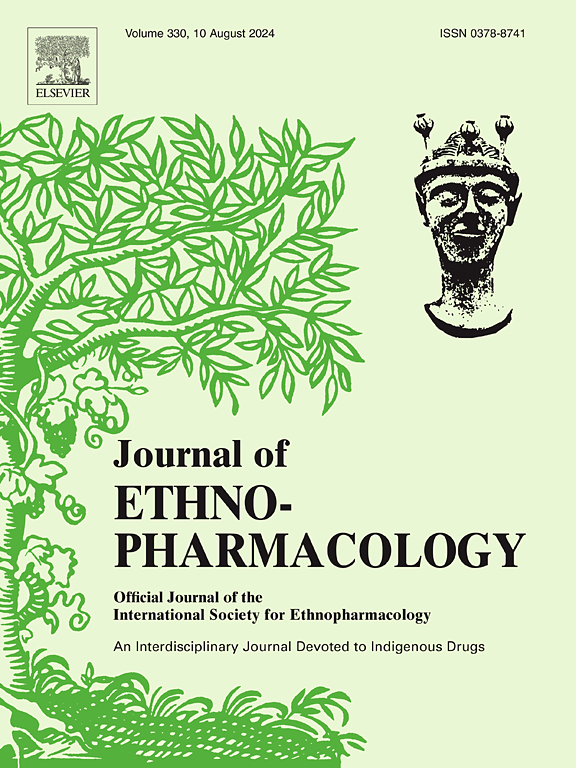4-Hydroxyboesenbergin B of Alpinia japonica protected gastrointestinal tract by inhibiting vancomycin-resistant enterococcus and balancing intestinal microbiota
IF 4.8
2区 医学
Q1 CHEMISTRY, MEDICINAL
引用次数: 0
Abstract
Ethnopharmacological relevance
Alpinia japonica, a traditional herb utilized in Miao medicine in southwestern China, has been employed to alleviate symptoms such as stomachache, diarrhea, and abdominal pain, some of these symptoms may be associated with bacterial infections of the gastrointestinal tract.
Aim of the study
To explore antimicrobial compounds related to traditional uses of A. japonica and its potential pathway in vitro and in vivo.
Materials and methods
Bioactive components of A. japonica were isolated by bioguide separation method. The antibacterial bioactivity of 4-hydroxyboesenbergin B (4-HB) was evaluated by time-kill curve and drug resistance induction. The pathway of 4-HB against VRE was investigated through network pharmacological analysis and validated by in vitro experiments and RT-qPCR assays. Moreover, a mouse gastrointestinal tract model was established to validate the antibacterial bioactivity of 4-HB in vivo.
Results
4-HB from A. japonica inhibited VRE (MIC = 16 μg/mL), rapidly killed the bacteria within 4 h at the 4 MIC concentration and exhibited low susceptibility to drug resistance. 4-HB specifically targeted VRE biofilms by down-regulating the expression of AtlA, SgrA, GelE, and Ace. As a result, 4-HB diminished the adhesion and aggregation ability of VRE, reduced the extracellular matrix content, disrupted biofilm structure and morphology, thereby reducing VRE resistance and virulence. Additionally, 4-HB significantly reduced VRE colonization, enhanced intestinal microbiota diversity, and promoted the restoration of intestinal microbiota balance in vivo. Notably, 4-HB enhanced the abundance of beneficial bacteria genera, such as Lactobacillus and Limosilactobacillus.
Conclusions
4-HB has a significant ability to destroy VRE biofilms and balance intestinal microbiota, which might be responsible for the traditional use of A. japonica partly.

4-Hydroxyboesenbergin B通过抑制万古霉素耐药肠球菌和平衡肠道菌群来保护胃肠道
民族药理学相关性:高山泻是中国西南苗族医学中使用的一种传统草药,已被用于缓解胃痛、腹泻和腹痛等症状,其中一些症状可能与胃肠道细菌感染有关。目的在体外和体内探索与粳稻传统用途相关的抗菌化合物及其潜在途径。材料与方法采用生物引导分离法分离粳稻的生物活性成分。采用时间杀伤曲线法和耐药诱导法评价4-hydroxyboesenbergin B (4-HB)的抗菌活性。通过网络药理学分析研究4-HB抗VRE的途径,并通过体外实验和RT-qPCR验证。建立小鼠胃肠道模型,验证4-HB在体内的抗菌生物活性。结果日本刺参4- hb对VRE有抑制作用(MIC = 16 μg/mL),在4 MIC浓度下4 h内迅速杀死细菌,耐药敏感性低。4-HB通过下调AtlA、SgrA、GelE和Ace的表达特异性靶向VRE生物膜。结果,4-HB降低了VRE的粘附和聚集能力,降低了细胞外基质含量,破坏了生物膜的结构和形态,从而降低了VRE的耐药性和毒力。4-HB显著降低VRE定殖,增强肠道菌群多样性,促进体内肠道菌群平衡的恢复。值得注意的是,4-HB增加了有益菌属的丰度,如乳酸杆菌和乳酸杆菌。结论4- hb具有明显的破坏VRE生物膜和平衡肠道菌群的能力,这可能是粳米传统使用的部分原因。
本文章由计算机程序翻译,如有差异,请以英文原文为准。
求助全文
约1分钟内获得全文
求助全文
来源期刊

Journal of ethnopharmacology
医学-全科医学与补充医学
CiteScore
10.30
自引率
5.60%
发文量
967
审稿时长
77 days
期刊介绍:
The Journal of Ethnopharmacology is dedicated to the exchange of information and understandings about people''s use of plants, fungi, animals, microorganisms and minerals and their biological and pharmacological effects based on the principles established through international conventions. Early people confronted with illness and disease, discovered a wealth of useful therapeutic agents in the plant and animal kingdoms. The empirical knowledge of these medicinal substances and their toxic potential was passed on by oral tradition and sometimes recorded in herbals and other texts on materia medica. Many valuable drugs of today (e.g., atropine, ephedrine, tubocurarine, digoxin, reserpine) came into use through the study of indigenous remedies. Chemists continue to use plant-derived drugs (e.g., morphine, taxol, physostigmine, quinidine, emetine) as prototypes in their attempts to develop more effective and less toxic medicinals.
 求助内容:
求助内容: 应助结果提醒方式:
应助结果提醒方式:


